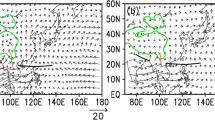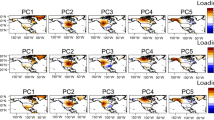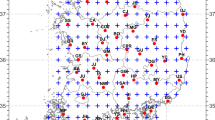Abstract
This paper investigates and quantifies co-variability between large-scale convection in the South American and Southern African sectors at different timescales (interannual, intraseasonal and synoptic), during the austral summer seasons (November–February) from 1979 to 2012. Multivariate analyses (Canonical Correlation Analysis and Principal Component Analysis) are applied to daily outgoing longwave radiation (OLR, used as a proxy for atmospheric convection) anomalies to extract the principal modes of variability and co-variability in each and between both regions, filtered to consider the appropriate time-scales. At the interannual timescale, results confirm the predominant role of El Niño Southern Oscillation (ENSO), favoring enhanced convection over both southeastern Brazil and northern Argentina on the one hand, and tropical Africa and the western Indian Ocean on the other hand. At the intraseasonal timescale, the leading mode of co-variability is related to modulations of large-scale atmospheric convection over most of South America, and 10 days later, tropical Southern Africa. This mode accounts for the impacts of the Madden–Julian-oscillation (MJO) over these regions: identifying robust co-variability at the intraseasonal timescale between both regions require thus to consider a temporal shift between the two sectors. At the synoptic scale, however, co-variability consists mostly of a synchronous modulation of the large-scale atmospheric convection over the South American and Southern African sectors. This results from the development of concomitant Rossby waves forming a continuous wave train over the South Atlantic in the mid-latitudes, affecting both the South Atlantic and South Indian Convergence Zones. Among the days when convection shows significant anomalies (30 % of the total days in each sector), this synchronous mode occurs about 25 % of the time, individual Rossby waves modulating convection over one single region only during the remaining 75 % events. Another mode of co-variability, involving a single Rossby wave modulating the convection first over the Americas, and 4 days later over Africa, appears as sensibly weaker than the synchronous mode, suggesting that the “wave train” mode occurs more frequently than the development and propagation of a single wave that could affect both regions.













Similar content being viewed by others
References
Bantzer CH, Wallace JM (1996) Intraseasonal variability in tropical mean temperature and precipitation and their relation to the tropical 40–50 days oscillation. J Atmos Sci 53:3032–3045. doi:10.1175/1520-0469(1996)053<3032:IVITMT>2.0.CO;2
Barreiro M, Chang P, Saravanan R (2002) Variability of the South Atlantic convergence zone simulated by an atmospheric general circulation model. J Clim 15:745–763. doi:10.1175/1520-0442(2002)015<0745:VOTSAC>2.0.CO;2
Behera SK, Yamagata T (2001) Subtropical SST dipole events in the southern Indian Ocean. Geophys Res Lett 28:327–330. doi:10.1029/2000GL011451
Boulard D, Pohl B, Crétat J et al (2013) Downscaling large-scale climate variability using a regional climate model: the case of ENSO over Southern Africa. Clim Dyn 40:1141–1168. doi:10.1007/s00382-012-1400-6
Carvalho LMV, Jones C, Liebmann B (2002a) Extreme precipitation events in southeastern South America and large-scale convective patterns in the South Atlantic convergence zone. J Clim 15:2377–2394
Carvalho LMV, Jones C, Silva Dias MAF (2002b) Intraseasonal large-scale circulations and mesoscale convective activity in tropical South America during the TRMM-LBA campaign. J Geophys Res 107:D20. doi:10.1029/2001JD000745
Carvalho LMV, Jones C, Liebmann B (2004) The South Atlantic convergence zone: intensity, form, persistence, and relationships with intraseasonal to interannual activity and extreme rainfall. J Clim 17:88–108
Carvalho LMV, Silva AE, Jones C et al (2011) Moisture transport and intraseasonal variability in the South America monsoon system. Clim Dyn 36:1865–1880. doi:10.1007/s00382-010-0806-2
Casarin DP, Kousky VE (1986) Anomalias de Precipitação No Sul Do Brasil E Variações Na Circulaçtío Atmosférica. Rev Bras Meteorol 1:83–90
Cazes-Boezio G, Robertson AW, Mechoso CR (2003) Seasonal dependence of ENSO teleconnections over South America and relationships with precipitation in Uruguay. J Clim 16:1159–1176. doi:10.1175/1520-0442(2003)16<1159:SDOETO>2.0.CO;2
Cook KH (2000) The South Indian convergence zone and interannual rainfall variability over Southern Africa. J Clim 13:3789–3804
Cook KH (2001) A southern hemisphere wave response to ENSO with implications for Southern Africa precipitation. J Atmos Sci 58:2146–2162. doi:10.1175/1520-0469(2001)058<2146:ASHWRT>2.0.CO;2
Cook KH (2003) Reply to “Comments on” the South Indian convergence zone and interannual rainfall variability over Southern Africa “and the question of ENSO’s influence on Southern Africa”. J Clim 16:563–565
Cook KH, Hsieh JS, Hagos SM (2004) The Africa–South America intercontinental teleconnection. J Clim 17:2851–2865. doi:10.1175/1520-0442(2004)017<2851:TAAIT>2.0.CO;2
Dee DP, Uppala SM, Simmons AJ et al (2011) The ERA-interim reanalysis: configuration and performance of the data assimilation system. Q J R Meteorol Soc 137:553–597. doi:10.1002/qj.828
Der Mégréditchian G (1992) Le Traitement Statistique des données multi-dimensionnelles: Application à la Météorologie, vol 1, Cours et Manuels 8, Météo-France, p 287
Fauchereau N, Pohl B, Reason CJC et al (2009) Recurrent daily OLR patterns in the Southern Africa/Southwest Indian Ocean region, implications for South African rainfall and teleconnections. Clim Dyn 32:575–591. doi:10.1007/s00382-008-0426-2
Fauchereau N, Pohl B, Lorrey A (2016) Extratropical Impacts of the Madden–Julian oscillation over New Zealand from a weather regime perspective. J Clim 29:2161–2175. doi:10.1175/JCLI-D-15-0152.1
Figueroa SN, Satyamurty P, Silva Dias PL (1995) Simulations of the summer circulation over the South American region with an eta coordinate model. J Atmos Sci 52:1573–1584
Flatau M, Kim Y-J (2013) Interaction between the MJO and polar circulations. J Clim 26:3562–3574. doi:10.1175/JCLI-D-11-00508.1
Grimm A, Reason CJC (2015) Intraseasonal teleconnections between South America and southern Africa. J Clim 28:9489–9497. doi:10.1175/JCLI-D-15-0116.1
Grimm AM, Barros VR, Doyle ME (2000) Climate variability in Southern South America associated with El Niño and La Niña Events. J Clim 13:35–58. doi:10.1175/1520-0442(2000)013<0035:CVISSA>2.0.CO;2
Hart NCG, Reason CJC, Fauchereau N (2013) Cloud bands over southern Africa: seasonality, contribution to rainfall variability and modulation by the MJO. Clim Dyn 41:1199–1212. doi:10.1007/s00382-012-1589-4
Jorgetti T, da Silva Dias PL, de Freitas ED et al (2014) The relationship between South Atlantic SST and SACZ intensity and positioning. Clim Dyn 42:3077–3086. doi:10.1007/s00382-013-1998-z
Jury MR (2002) Economic impacts of climate variability in South Africa and development of resource prediction models. J Appl Meteorol 41:46–55. doi:10.1175/1520-0450(2002)041<0046:EIOCVI>2.0.CO;2
Kalnay E, Kanamitsu M, Kistler R et al (1996) The NCEP/NCAR 40-year reanalysis project. Bull Am Meteorol Soc 77:437–471
Kodama YM (1992) Large-scale common features of subtropical precipitation zones (the Baiu Frontal zone, the SPCZ, and the SACZ). Part I: characteristics of subtropical frontal zones. J Meteorol Soc Jpn 70:813–836
Kodama YM (1993) Large-scale common features of subtropical convergence zones (the Baiu frontal zone, the SPCZ, and the SACZ). Part II: conditions of the circulations for generating the STCZs. J Meteorol Soc Jpn 71:581–610
Krishnamurthy V, Misra V (2010) Observed ENSO teleconnections with the South American monsoon system. Atmos Sci Lett 11:7–12. doi:10.1002/asl.245
Kuhnel I (1989) Tropical-extratropical cloudband climatology based on satellite data. Int J Climatol 9:441–463
Lenters JD, Cook KH, Ringler TD (1995) Comments on “On the influence of the Andes on the general circulation of the Southern emisphere”. J Clim 8:2113–2115
Liebmann B, Smith CA (1996) Description of a complete (interpolated) outgoing long wave radiation dataset. Bull Am Meteorol Soc 77:1275–1277
Liebmann B, Kiladis GN, Marengo JA et al (1999) Submonthly convective variability over South America and the South Atlantic convergence zone. J Clim 12:1877–1891
Lyon B, Mason SJ (2007) The 1997–1998 summer rainfall season in Southern Africa. Part I: observations. J Clim 20:5134–5148. doi:10.1175/JCLI4225.1
Lyon B, Mason SJ (2009) The 1997/1998 summer rainfall season in Southern Africa. Part II: model simulations and coupled model forecasts. J Clim 22:3802–3818. doi:10.1175/2009JCLI2600.1
Macron C, Pohl B, Richard Y, Bessafi M (2014) How do tropical temperate troughs form and develop over Southern Africa? J Clim 27:1633–1647. doi:10.1175/JCLI-D-13-00175.1
Madden RA, Julian PR (1971) Detection of a 40–50 days oscillation in the zonal wind in the tropical Pacific. J Atmos Sci 28:702–708
Madden RA, Julian PR (1972) Description of Global-Scale circulation cells in the tropics with a 40–50 days period. J Atmos Sci 29:1109–1123
Madden RA, Julian PR (1994) Observations of the 40–50-days tropical oscillation—a review. Mon Weather Rev 122:814–837
Mason SJ, Jury MR (1997) Climatic variability and change over southern Africa: a reflection on underlying processes. Prog Phys Geogr 21:23–50. doi:10.1177/030913339702100103
Matthews AJ (2000) Propagation mechanism for the Madden–Julian oscillation. Q J R Meteorol Soc 126:2637–2652
Matthews AJ, Meredith MP (2004) Variability of Antarctic circumpolar transport and the Southern Annular mode associated with the Madden–Julian oscillation. Geophys Res Lett 31:L24312. doi:10.1029/2004GL021666
Misra V (2003) The influence of Pacific SST variability on the precipitation over Southern Africa. J Clim 16:2408–2418
Nicholson SE (1997) An analysis of the ENSO signal in the tropical Atlantic and western Indian oceans. Int J Climatol 17:345–375
Nicholson SE (2015) Long-term variability of the East African “short rains” and its links to large-scale factors. Int J Climatol. doi:10.1002/joc.4259
Nicholson SE, Kim J (1997) The relationship of the El Niño-Southern Oscillation to African rainfall. Int J Climatol 17:117–135
Oettli P, Tozuka T, Izumo T et al (2014) The self-organizing map, a new approach to apprehend the Madden–Julian oscillation influence on the intraseasonal variability of rainfall in the southern African region. Clim Dyn 43:1557–1573. doi:10.1007/s00382-013-1985-4
Pohl B, Matthews AJ (2007) Observed changes in the lifetime and amplitude of the Madden–Julian oscillation associated with interannual ENSO sea surface temperature anomalies. J Clim 20:2659–2674. doi:10.1175/JCLI4230.1
Pohl B, Richard Y, Fauchereau N (2007) Influence of the Madden–Julian oscillation on Southern African summer rainfall. J Clim 20:4227–4242. doi:10.1175/JCLI4231.1
Pohl B, Fauchereau N, Richard Y et al (2009) Interactions between synoptic, intraseasonal and interannual convective variability over Southern Africa. Clim Dyn 33:1033–1050. doi:10.1007/s00382-008-0485-4
Pohl B, Fauchereau N, Reason CJC, Rouault M (2010) Relationships between the Antarctic oscillation, the Madden–Julian oscillation, and ENSO, and consequences for rainfall analysis. J Clim 23:238–254. doi:10.1175/2009JCLI2443.1
Rayner NA, Brohan P, Parker DE et al (2006) Improved analyses of changes and uncertainties in sea surface temperature measured in situ since the mid-nineteenth century: the HadSST2 dataset. J Clim 19:446–469
Reason CJC, Jagadheesha D (2005) A model investigation of recent ENSO impacts over southern Africa. Meteorol Atmos Phys 89:181–205. doi:10.1007/s00703-005-0128-9
Robertson AW, Mechoso C (2000) Interannual and decadal variability of the South Atlantic convergence zone. Mon Weather Rev 128:2947–2957
Salby ML, Hendon HH (1994) Intraseasonal behavior of clouds, temperature, and motion in the tropics. J Atmos Sci 51:2207–2224. doi:10.1175/1520-0469(1994)051<2207:IBOCTA>2.0.CO;2
Simmons AJ, Uppala SM, Dee DP, Kobayashi S (2007) ERA-interim: new ECMWF reanalysis products from 1989 onwards. ECMWF Newsl 110:25–35
Solman SA (2013) Regional climate modeling over South America: a review. Adv Meteorol 2013:504357. doi:10.1155/2013/504357
Streten NA (1973) Some characteristics of satellite-observed bands of persistent cloudiness over the southern hemisphere. Mon Weather Rev 101:486–495. doi:10.1175/1520-0493(1973)101<0486:SCOSBO>2.3.CO;2
Todd MC, Washington R (1998) Extreme daily rainfall in southern Africa and southwest Indian Ocean: tropical–temperate links. S Afr J Sci 94:64–70
Todd M, Washington R (1999) Circulation anomalies associated with tropical–temperate troughs in southern Africa and the south west Indian Ocean. Clim Dyn 15:937–951. doi:10.1007/s003820050323
Van Der Wiel K, Matthews AJ, Stevens P, Joshi MM (2015) A dynamical framework for the origin of the diagonal South Pacific and South Atlantic convergence zones. Q J R Meteorol Soc 141:1997–2010. doi:10.1002/qj.2508
Vigaud N, Pohl B, Crétat J (2012) Tropical–temperate interactions over southern Africa simulated by a regional climate model. Clim Dyn 39:2895–2916. doi:10.1007/s00382-012-1314-3
Vincent DG (1994) The South Pacific convergence zone (SPCZ): a review. Mon Weather Rev 122:1949–1970
Wheeler MC, Hendon HH (2004) An all-season real-time multivariate MJO Index: development of an index for monitoring and prediction. Mon Weather Rev 132:1917–1932
Widlansky MJ, Webster PJ, Hoyos CD (2011) On the location and orientation of the South Pacific convergence zone. Clim Dyn 36:561–578. doi:10.1007/s00382-010-0871-6
Wolter K, Timlin MS (1993) Monitoring ENSO in COADS with a seasonally adjusted principal component index. In: Norman OK (ed) 17th clim. diagnostics work. pp 52–57
Zhang C (2005) Madden–Julian oscillation. Rev Geophys 43:RG2003. doi:10.1029/2004RG000158
Acknowledgments
The authors thank Dr. Josyane Ronchail for helpful comments that helped improve the manuscript, and two anonymous reviewers for their suggestions that helped improve the manuscript. ERA-Interim data were provided by ECMWF. N. Fauchereau acknowledges funding provided by the NIWA project “Climate Present and Past” CAOA1601 within the Climate Observations Programme in the National Climate Centre. Calculations were performed using HPC resources from DSI-CCuB (université de Bourgogne).
Author information
Authors and Affiliations
Corresponding author
Additional information
This study is dedicated to the memory of Professor Gérard Beltrando.
Electronic supplementary material
Below is the link to the electronic supplementary material.
382_2016_3318_MOESM1_ESM.eps
Figure S1 Principal component analysis of OLR anomalies over the “South American” sector, period NDJF 1979–2012. The first three modes are significant according to a scree-test. All spatial patterns are correlation maps with the principal component time series. Dashed curves show the 95 % significance bound according to a Bravais-Pearson test. The variance explained by each mode is labeled in the figure. (EPS 1023 kb)
Appendix: Dominant modes of large-scale convective variability in each region
Appendix: Dominant modes of large-scale convective variability in each region
The Canonical Correlation Analyses used in this work aim at maximizing the co-variability between two domains. The modes extracted could possibly differ from the leading modes of variability calculated for each region separately. This case would imply that the mode extracted probably accounts for a reduced fraction of the regional climate variability in each region and could thus correspond more to a statistical artifact than a physically robust mechanism.
Figures S1 and S2 present therefore the leading EOF of PCA applied to raw (unfiltered) OLR anomalies in each region. Both analyses extract the robust variability patterns, already presented in many previous papers for both regions (e.g. Carvalho et al. 2004; Pohl et al. 2009), which are associated with the spatio-temporal variability of both CZ. These patterns sensibly differ from those found at the interannual (Fig. 2) and intraseasonal (Fig. 5) timescales, which are discussed in this study. The latter are however in fair agreement with the spatial signature of ENSO and the MJO over these sectors, respectively, which confirms the hypothesis of significant co-variabilities caused by the common influence of a single, larger-scale atmospheric or climatic phenomenon encompassing both regions.
The spatial similarity is largest for the synoptic scale, counter-balancing a weaker and intermittent temporal co-variability. For this timescale, one can thus conclude that the mode of co-variability shown in Fig. 9 corresponds to the leading variability patterns influencing each region. Unlike the longer timescales, one can here conclude on co-variability between the “SACZ” and “SICZ”, strictly speaking, and not merely on the South American and Southern African regions.
Rights and permissions
About this article
Cite this article
Puaud, Y., Pohl, B., Fauchereau, N. et al. Climate co-variability between South America and Southern Africa at interannual, intraseasonal and synoptic scales. Clim Dyn 48, 4029–4050 (2017). https://doi.org/10.1007/s00382-016-3318-x
Received:
Accepted:
Published:
Issue Date:
DOI: https://doi.org/10.1007/s00382-016-3318-x




